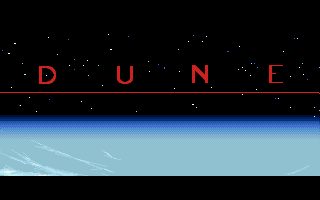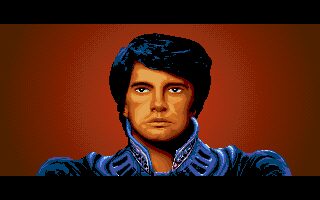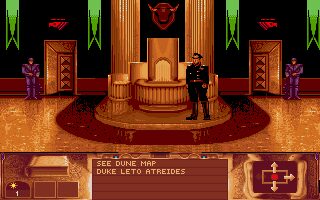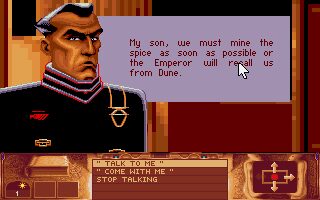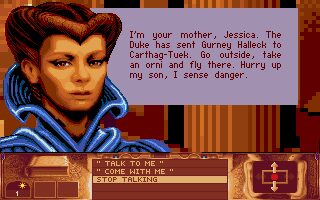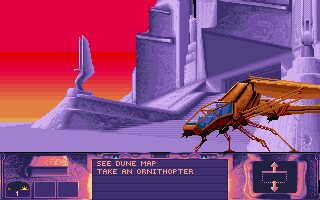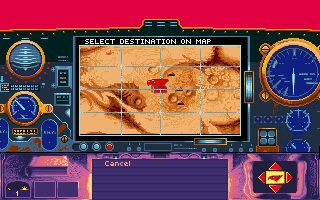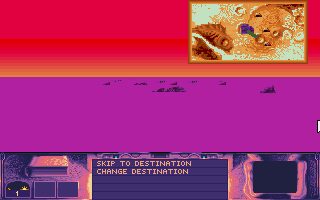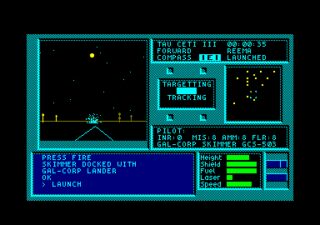Dune is a strategy adventure developed by Cryo Interactive and published by Virgin Games in 1992 for Amiga and PC. Based on the famous Frank Herbert's sci-fi novel, the game was also ported to CD and released for the Sega CD console.
Strangely enough, Dune is not connected to Dune II: The Battle For Arrakis, which was developed by another software house, and it's an entirely different game.
In Dune, the player takes control of Paul Atreides. The emperor of the universe sent Paul's family to planet Arrakis, also known as Dune. Their goal is to mine the Melange, the most valuable spice in the universe. Quickly the involved ones realize that it is a challenging mission because on that same planet inhabits the Harkonnen, mortal enemies of the family.
The gameplay is quite complex. Although it seems only a graphic adventure, a much more strategic gameplay is revealed as the story progresses. In this case, the player's main objective is to obtain the spice; the complicated thing is what to do with it. First, the player must use it to hire troops to acquire military training and items to fight the Harkonnen. On the other hand, he cannot forget that he works for the emperor. If he doesn't send the requested amount of Melange, he will send a troop to kill him, and it's immediately game over. As the game progresses, the gameplay subtly changes. New characters and locations are unlocked, and the Harkonnen becomes more aggressive. Besides, a new factor appears: The player starts to take care of the planet's ecology to bring it back to life.
Another vital point of the gameplay is exploration. As the plot progresses, more and more places are unlocked to visit and continue with the adventure. Although quick travel between locations is possible, the user can opt for manual exploration. In this way, he travels on his ship while looking at the dunes on the way. The player can also ask another character to accompany him on his journeys. This, more than being an aesthetic resource, the fact that each companion has different benefits, opens new gameplay frontiers. Among these elements and newfound powers that the character acquires in the middle of the game, the title finally revolves around accompanying Paul Atreides in his ascent to power.
The graphics of the title perfectly accompany the theme that surrounds Arrakis. It could be said that yellow predominates due to the desert nature of the planet, but this is not the only reason. In several moments of the game, it can be noticed how this was a creative decision and not a coincidence. This is based on the fact that the players' skin has a more yellowish tone than usual. The dialogue boxes, the structures, and even filters in which the game is immersed obey this warm palette.
In the design of the characters, there is a clear inspiration in Dune's film adaptation, directed by David Lynch, a director who requires no introduction. Both the faces of the characters and the construction of the landscapes are built as direct references to its actors and locations. Another great detail of the game is the effort implemented in the graphic part. Without relying on resources like live-action, the developers built some sensational visuals. The soundtrack is composed by Stéphane Picq and Philip Ulrich. Throughout the game, the user experiences music that generates a sense of mystery that encourages exploration. Moreover, a constant aura of caution is also present.
The critics received the game in a good way. The title sold 20,000 copies in its first week and 300,000 by 1996. The reviewers agreed that Cryo's most outstanding achievement was simplifying a very complex novel and turning it into a perfect video game.
In short, Dune is a game without waste. Whether you are a fan of the book, the game, the movie, or even none of these, the strategic nature and plot surrounding the title will make you addicted to it.

